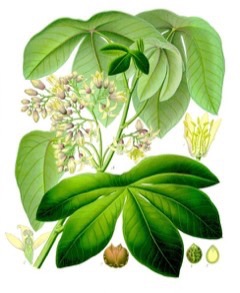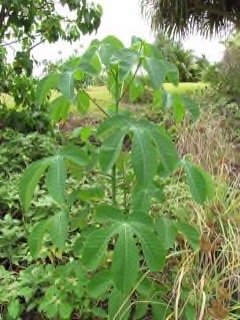 |
|
edibleplants.org |
 |
| Forest Starr & Kim Starr starrenvironmental.com |
Translate this page:
Summary
Physical Characteristics

 Manihot carthaginensis glaziovii is a deciduous Tree growing to 6 m (19ft) by 4 m (13ft) at a fast rate.
Manihot carthaginensis glaziovii is a deciduous Tree growing to 6 m (19ft) by 4 m (13ft) at a fast rate.
See above for USDA hardiness. It is hardy to UK zone 10.
Suitable for: light (sandy), medium (loamy) and heavy (clay) soils, prefers well-drained soil and can grow in heavy clay and nutritionally poor soils. Suitable pH: mildly acid, neutral and basic (mildly alkaline) soils and can grow in very acid soils.
It cannot grow in the shade. It prefers dry moist or wet soil and can tolerate drought.
UK Hardiness Map
US Hardiness Map
Synonyms
Manihot glaziovii Müll.Arg.
Plant Habitats
Edible Uses
Edible Parts: Leaves Root
Edible Uses:
Leaves - cooked[303 ]. Eaten as a vegetable[303 ]. The leaves contain hydrocyanic acid, which is toxic, but it is destroyed by heat and so the cooked leaves are safe to eat[303 ]. Root - cooked[301 , 303 ]. A famine food, it is eaten in times of food scarcity[303 ]. The root is rich in starch but it is hard and woody[303 ]. It also contains hydrocyanic acid (see note above re the leaves)[303 ]. Seed - oily[301 ].
References More on Edible Uses
Medicinal Uses
Plants For A Future can not take any responsibility for any adverse effects from the use of plants. Always seek advice from a professional before using a plant medicinally.
The stem and root are ingredients in a remedy for skin infections[303 ].
References More on Medicinal Uses
The Bookshop: Edible Plant Books
Our Latest books on Perennial Plants For Food Forests and Permaculture Gardens in paperback or digital formats.

Edible Tropical Plants
Food Forest Plants for Hotter Conditions: 250+ Plants For Tropical Food Forests & Permaculture Gardens.
More

Edible Temperate Plants
Plants for Your Food Forest: 500 Plants for Temperate Food Forests & Permaculture Gardens.
More

More Books
PFAF have eight books available in paperback and digital formats. Browse the shop for more information.
Shop Now
Other Uses
Agroforestry Uses: The tree is used to provide temporary shade for cocoa plants[303 ]. The leaves are applied as green leaf manure[303 ]. In some areas, especially where the rainfall is low, the species is used as a hedge[303 ]. Other Uses: The plant is used in breeding programmes for cassava (Manihot esculenta), being used to improve disease resistance[303 ]. The tree is a source of latex that can be used to make rubber[303 ]. The rubber is said to be of good appearance, but the resin content, at 3 - 12%, is too high[303 ], It is, therefore, considered to be uneconomical when there are other sources. The latex can be used as a glue for paper[303 ]. The seeds contain 90 % unsaturated oil[303 ]. (This seems a very high figure[K ].) The oil might possibly be used as a fuel for pre-combustion diesel engines[303 ]. The wood is coarse-textured, straight-grained, very light in weight, very susceptible to wood-eating organisms[625 ]. Easy to cut but of quite low quality, it is used to make items such use boxes[625 ].
Special Uses
Carbon Farming
References More on Other Uses
Cultivation details
Agroforestry Services: Crop shade Industrial Crop: Hydrocarbon Management: Standard Regional Crop
A plant of the semi-arid tropics, where it is found at elevations from sea level up to 1,200 metres[303 ]. It grows in areas where the mean annual rainfall is within the range 600 - 700mm[303 ]. Prefers a position in a sunny position[625 ]. The tree tolerates a wide range of soils including very poor and acidic soils[303 ]. It can succeed in sticky red soil, which may be water logged[303 ]. Established plants are very drought tolerant[303 ]. Plants have escaped from cultivation in many of the areas in which they have been grown[305 ]. They are reported to be invasive in Hawaii[305 ]. The growth of young plants is rapid[625 ]. The plant can flower the whole year through, it probably also fruits the year round but no data is available[303 ]. The tree can be tapped at the age of 3 years[303 ].
Carbon Farming
-
Agroforestry Services: Crop shade
Plants providing crop shade especially trees.
-
Industrial Crop: Hydrocarbon
Materials, chemicals and energy include bioplastics, rubber, biomass products gasoline, jet fuel, diesel, butane, propane, biogas. Plants are usually resprouting plants and saps.
-
Management: Standard
Plants grow to their standard height. Harvest fruit, seeds, or other products. Non-Destructive management systems.
-
Regional Crop
These crops have been domesticated and cultivated regionally but have not been adopted elsewhere and are typically not traded globally, Examples in this broad category include perennial cottons and many nuts and staple fruits.
References Carbon Farming Information and Carbon Sequestration Information
Temperature Converter
Type a value in the Celsius field to convert the value to Fahrenheit:
Fahrenheit:
The PFAF Bookshop
Plants For A Future have a number of books available in paperback and digital form. Book titles include Edible Plants, Edible Perennials, Edible Trees,Edible Shrubs, Woodland Gardening, and Temperate Food Forest Plants. Our new book is Food Forest Plants For Hotter Conditions (Tropical and Sub-Tropical).
Shop Now
Plant Propagation
Seed - usually sown in situ[303 ]. Seed - best sown as soon as it is ripe in a partially shaded position in a nursery seedbed. A germination rate of around 50% can be expected, with the seed sprouting within 30 - 50 days[625 ]. Cuttings[303 ].
Other Names
If available other names are mentioned here
Ceara Rubber Tree, False Tapioca, Manicoba, Ubi. French - manioc de ceara, maniçoba, ceara, caouchouc de ceara. Portuguese - manicoba. Swahili - mpira. Yoruba - gbaguda
Native Range
Coming Soon
Weed Potential
Right plant wrong place. We are currently updating this section.
Please note that a plant may be invasive in one area but may not in your area so it's worth checking.
Plants have escaped from cultivation in many of the areas in which they have been grown[305 ]. They are reported to be invasive in Hawaii[305 ]. The growth of young plants is rapid[625 ].
Conservation Status
IUCN Red List of Threatened Plants Status : This taxon has not yet been assessed

Growth: S = slow M = medium F = fast. Soil: L = light (sandy) M = medium H = heavy (clay). pH: A = acid N = neutral B = basic (alkaline). Shade: F = full shade S = semi-shade N = no shade. Moisture: D = dry M = Moist We = wet Wa = water.
Now available:
Food Forest Plants for Mediterranean Conditions
350+ Perennial Plants For Mediterranean and Drier Food Forests and Permaculture Gardens.
[Paperback and eBook]
This is the third in Plants For A Future's series of plant guides for food forests tailored to
specific climate zones. Following volumes on temperate and tropical ecosystems, this book focuses
on species suited to Mediterranean conditions—regions with hot, dry summers and cool, wet winters,
often facing the added challenge of climate change.
Read More
Expert comment
Author
(Müll.Arg.) Allem
Botanical References
Links / References
For a list of references used on this page please go here
A special thanks to Ken Fern for some of the information used on this page.
Readers comment
| Add a comment |
|
If you have important information about this plant that may help other users please add a comment or link below. Only comments or links that are felt to be directly relevant to a plant will be included. If you think a comment/link or information contained on this page is inaccurate or misleading we would welcome your feedback at [email protected]. If you have questions about a plant please use the Forum on this website as we do not have the resources to answer questions ourselves.
* Please note: the comments by website users are not necessarily those held by PFAF and may give misleading or inaccurate information.
To leave a comment please Register or login here All comments need to be approved so will not appear immediately.
|
Subject : Manihot carthaginensis glaziovii
|
|
|
|